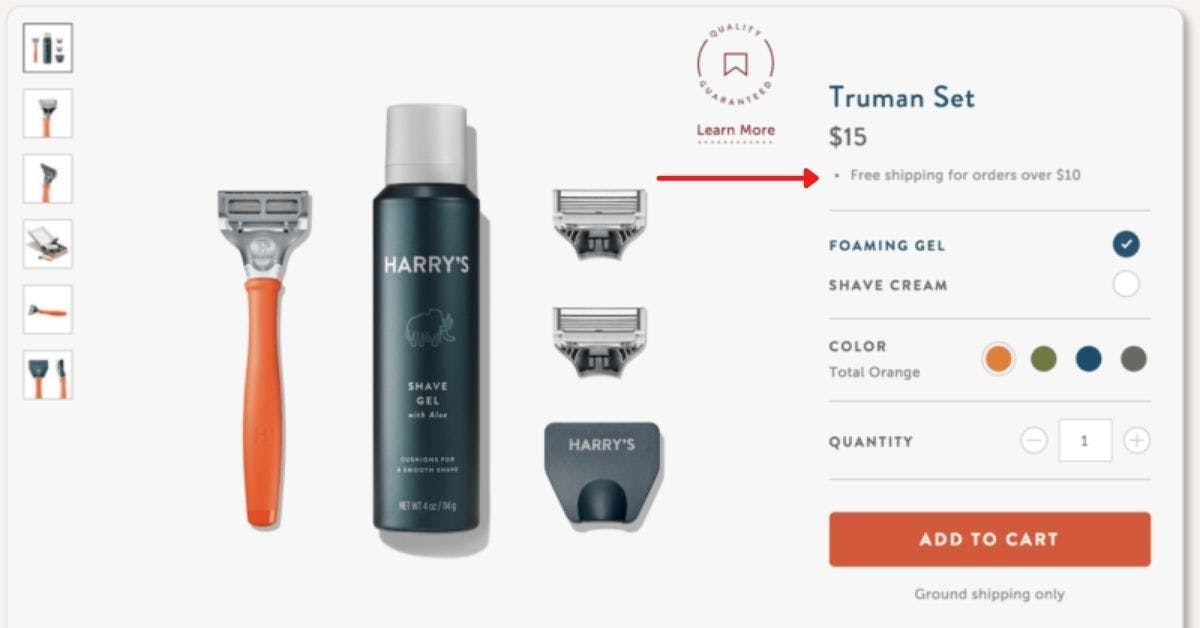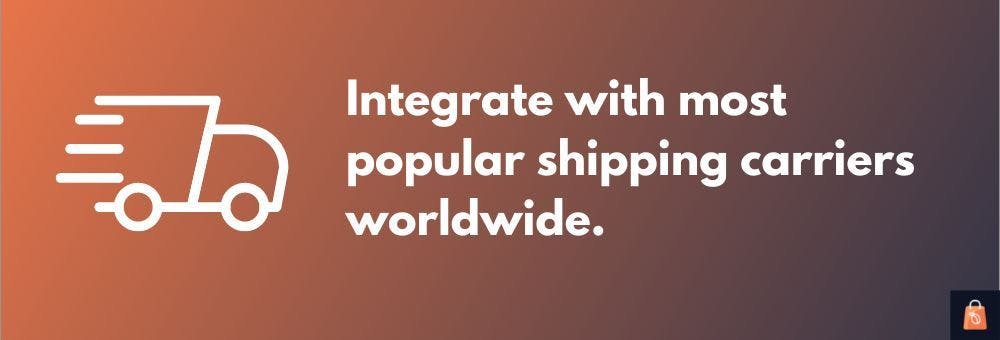The State of Ecommerce Shipping in 2023

By Srishty
Posted | 13 min read
Ecommerce shipping refers to the process of delivering goods purchased online to customers. In recent years, the ecommerce industry has been growing rapidly, driven by the increasing use of the internet and mobile devices, as well as advancements in technology and logistics. As a result, ecommerce shipping has become a critical component of the online shopping experience.
Ecommerce companies are now facing the challenge of meeting the demands of consumers for fast and convenient delivery options, while also addressing concerns about sustainability and cost-effectiveness.
In response to this, many companies are investing in new technologies and logistics solutions to improve their shipping operations and offer more options to customers. Some companies also offer options such as click and collect, subscription based delivery, and other services to improve the shopping experience.
There has also been a recent trend towards more sustainable shipping practices, such as reducing packaging and emissions, and using more eco-friendly delivery methods.
If you are a small business owner who has newly dived into the world of ecommerce, then this article can help you in understanding the basics of ecommerce fulfillment, same day delivery, shipping integrations with popular ecommerce platforms and more. Let's take a look-
What Is Ecommerce Shipping?
These are all terms you should be familiar with when considering about ecommerce fulfillment. It could seem straightforward enough. It might even appear straightforward if you've seen a well-run warehouse. However, the complexity that results from all the moving parts depends on a number of factors, including the sorts and sizes of the products you sell, the locations to which you'll ship, the delivery options and shipping rates you decide to provide, and more.
Shipping work would mean you to familiarize yourself with the terms like shipping carrier, ecommerce shipping strategy, multiple shipping companies, receiving and processing orders, selecting and packing the purchased item at a warehouse, generating shipping labels, and even managing returns.
These are all terms you should be familiar with when considering about ecommerce fulfillments. It could seem straightforward enough. It might even appear straightforward if you've seen a well-run warehouse. However, the complexity that results from all the moving parts depends on a number of factors, including the sorts and sizes of the products you sell, the locations to which you'll ship, the delivery options and shipping rates you decide to provide, and more.
Unbeknownst to many, an e-commerce shipping strategy is crucial.
Customers want:
- Quick
- Inexpensive
- Simple to manage
Providing all of these things might help you stand out from the competition.
Types of shipping methods in ecommerce
If you do the unit economics of your business right, you'd still be able to provide free shipping services for your customers. As you may know that free shipping is never free, it has to be accommodated somewhere in the product prices or in the form of discounts from the shipping services provider.
Learning ecommerce shipping process is very crucial to make any ecommerce business a success.
Generally speaking, combining quick and inexpensive shipping options can lower shopping cart abandonment and boost conversions. Here are six shipping options you might want to include in your e-commerce shipping plan.
1. The 2-Day Delivery System
2-day delivery has become associated with online shopping and a highly sought-after ecommerce shipping solution thanks to Amazon Prime or any such prime subscription. There are ways for all businesses to offer 2-day shipping to their consumers without going broke because the shipping cost is manageable despite the fact that this form of premium shipping may seem solely accessible to e-commerce behemoths.
In order to make 2-day delivery systems accessible to small businesses and solopreneurs. ecommerce platforms like Shopify and others are building their own fulfillment network.
2. Over Night Delivery
How can ecommerce firms differentiate themselves when two-day shipping is standard? Here comes overnight shipping, a means of delivery that ensures clients will get their orders the following business day. Various carriers provide various overnight shipping options at various pricing points. These types of ecommerce shipping cost more than usual.
Most of the times, businesses who provide such kind of services have partnership with shipping entities like Fedex, DHL, UPS and others. In practicality, over night delivery is more affordable for sellers who have bulk volumes for the quick delivery.
3. Free Shipping
Amazon Prime subscriptions have made it a norm for most of the customers to expect free shipping when shopping online. This negatively affects small website owners where consumers assume a similar behavior as that on Amazon when it comes to shipping prices.
If you do the unit economics of your business right, you'd still be able to provide free shipping services for your customers. As you may know that free shipping is never free, it has to be accommodated somewhere in the product prices or in the form of discounts from the shipping services provider.
For example, Harry's men's grooming and shaving supplies offers free shipping on bundled products, making sure that customers are buying more goods to the point that the company can afford free shipping for them.
Calculating shipping prices for a product
For your business to be successful in the long run, you must give your consumers the best shipping options and pricing.
If you price too much, you risk losing a customer, and if you charge too little, you risk losing profits. However, it goes beyond only the cost. Offering the appropriate shipping alternatives at the appropriate times helps lower cart abandonment and boost sales.
It is imperative for you to know how much shipping will cost you before you choose a shipping plan or decide how much it should cost your consumers. Let's take a look at some of the common ways of calculating shipping prices for customers.
1. Weight based pricing
This is the most common way used by ecommerce brands when it comes to calculating shipping costs for a product. Since weight and dimensions play an important role when a package is in transit, it make sense for most of the carriers and shipping aggregator platforms to use these units as a source to calculate shipping price for an item.
This approach works really well when majority of the shipments have a similar weight and dimensions. This way, it is easier to predict monthly shipping expenses which indirectly helps your marketing team is creating promotional offers like free shipping, buy one get one free etc.
2. Location based pricing
A flat pricing or weight based pricing works well when there's consistency - with the packaging as well as with the geographical locations. But this is seldomly true in ecommerce. As businesses sell to different geographies in the same country, or go global, things start getting complicated with shipping.
For example, pricing can be static to sell anywhere in the contiguous states in United States, but, when it comes to shipping from Texas to Alaska, pricing are going to be significantly different than those between Texas and Washington.
This is where location based pricing comes into picture. If bulk of your customers are international, then it makes sense to have a partnership with the carriers directly. Top carriers like UPS, DHL and Fedex offer such facilities to support businesses who sell internationally on large volume.
3. Rule based pricing
A popular approach is using shipping rules. This means that shipping cost is based on certain criteria such as item's weight, price, quantity, shipping destination, etc. This can be a good option for businesses that have different shipping prices for different products or destinations.
A good example would be someone who is selling home decor items online. In this case, glass items will require sturdy packaging and delicate handling which is going to increase shipping costs irrespective of the distance. On the other hand, wooden items of the same weight could be shipped at a much less rate,
4. Real time shipping rates
Finally, we talk about real-time shipping rates. This means that the shipping cost is calculated in real-time during the checkout process using shipping carrier APIs. This can be a good option for businesses who want to offer their customers a wide range of shipping options and ensure that they are getting the best rate possible.
API integrations often mean hiring tech teams who can build and maintain the integrations for you. On the other hand, if you are new to ecommerce, you can use platforms like Storeplum to quickly integrate with the most popular shipping aggregators used by online businesses.
Setting shipping prices for an ecommerce store can be a complex task but with the right approach, it can be simple and straightforward. Consider your costs, shipping destination, products, and customer's needs to create a shipping strategy that works for your business. It's also recommended to regularly review your shipping prices and adjust them as needed to ensure that you are providing your customers with the best possible service.
Popular shipping softwares in ecommerce
With timely deliveries and simple returns, shipping software may help you manage and organise your shipping procedures, save money on shipping, and boost customer happiness.
It is understandable why majority of online businesses need of shipping software. Still, there are several others which are unaware of the advantages of using such apps or aggregators.
With the help of shipping software, merchants can easily handle their orders and ship products using a variety of delivery providers at their disposal. A large number of aggregators can expedite and automate shipping and delivery procedures that individuals traditionally handled manually.
These apps can also pinpoint and resolve shipping-related problems far more easily than merchants manually following up with individual carriers. Let's take a look at some of the most popular shipping softwares in USA-
1. Shipstation
One of the most popular ecommerce shipping software options is Shipstation. This platform offers a wide range of features, including real-time shipping rates, label printing, order tracking, and integration with a variety of marketplaces and shopping carts. It also has powerful automation tools to help you manage and fulfill your orders more efficiently. Shipstation offers a free trial and pricing starts at $9 per month.
2. Shippo
The next best on the list is Shippo. Shippo provides access to discounted shipping rates from multiple carriers, including USPS, FedEx, and DHL. It also offers features such as label printing, tracking, and returns management. Shippo's pricing is based on the number of shipments you make per month, starting at $20 per month. Storeplum supports native integration to Shippo. This allows you to automatically sync your orders and generate shipping labels directly from your Storeplum dashboard.
3. ShippingEasy
ShippingEasy is another popular ecommerce shipping software. It offers features such as discounted shipping rates, label printing, and tracking, as well as automation tools for order management. It also has a wide range of integrations with marketplaces, shopping carts, and accounting software. ShippingEasy's pricing starts at $29 per month.
4. ShipWorks
ShipWorks is another ecommerce shipping software that offers a wide range of features, including discounted shipping rates, label printing, and tracking. It primarily serves businesses which have multiple locations with a minimum fixed volume of shipments each month.
This means if you are just starting with your online store then ShipWorks may not be suitable for you. ShipWorks offers a free trial and pricing starts at $29 per month.
5. EasyPost
This list would be incomplete without mentioning EasyPost. It is by far the most affordable shipping aggregator out there. At just $9 per month, EasyPost offers discounted shipping rates, label printing, tracking, and automation tools for order management. It also offers a wide range of integrations with marketplaces, shopping carts, and accounting software. EasyPost also offers a wide range of customization options, allowing businesses to design and print their own shipping labels, customize tracking pages
Shipping insurance
Shipping insurance is a type of coverage that protects the business and its customers from financial loss in the event that a package is lost, stolen, or damaged during transit. The coverage typically includes reimbursement for the cost of the item, as well as any shipping and handling costs. It is typically offered by shipping carriers and third-party providers and can be purchased as an add-on to the shipping cost.
There are several reasons why shipping insurance is important for an ecommerce business.
-
It provides peace of mind for both the business and its customers. If a package is lost or stolen, the business will be able to reimburse the customer for the cost of the item, which helps to maintain customer satisfaction and trust.
-
Shipping insurance helps to protect the business from financial loss. If a package is lost or stolen, the business will be able to recoup the cost of the item and any associated shipping costs.
-
Shipping insurance can also help to protect the business from liability in the event that a package is damaged during transit. If a customer receives a damaged item, the business will be able to reimburse the customer for the cost of the item, which helps to maintain customer satisfaction and trust. Finally, shipping insurance is often required by some marketplaces and payment processors as a condition of doing business with them.
When it comes to getting shipping insurance for your ecommerce business, there are several options available.
The first option is to purchase shipping insurance directly from the shipping carrier. Many shipping carriers, such as USPS, FedEx, and UPS, offer shipping insurance as an add-on to their shipping services. The cost of the insurance will depend on the carrier and the value of the item being shipped.
Another option is to purchase shipping insurance from a third-party provider. There are several third-party providers that offer shipping insurance, such as Shipsurance, Informed Delivery and Parcel Insurance Plan. These providers typically offer more comprehensive coverage and more flexible pricing options than the carriers.
When purchasing shipping insurance, it is important to consider the coverage offered, the cost of the insurance, and the claims process. It's also important to consider the value of the items you are shipping and how much coverage you need.
It's also recommended to read the policy's terms and conditions carefully before making a purchase, to make sure you understand what is and isn't covered.
Conclusion
Shipping is a crucial aspect of any online business. It not only ensures that customers receive their orders on time and in good condition, but it also plays a significant role in building customer satisfaction and trust.
In order to create an effective shipping strategy, businesses must consider their costs, shipping destinations, products, and customer needs. Utilizing the right ecommerce shipping software can help streamline the process and make it more efficient.
Shipping insurance is also an important consideration, providing protection from financial loss and liability, and it's recommended to understand what is and isn't covered in the policy. Ecommerce shipping is a complex task, but with the right approach, it can be simple and straightforward, helping businesses to grow and succeed.

Content writer at Storeplum. Ardent feminist. Working on two novels - "Chela" and "Feminists Vs. Who" in my free time.






